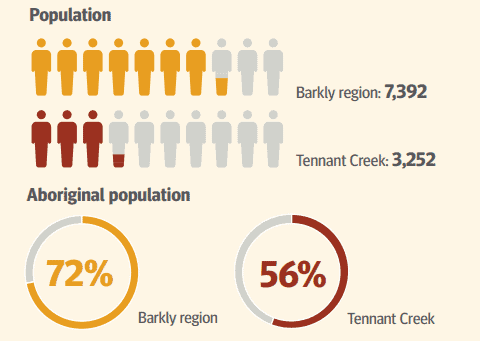Way of Working
Background to the Barkly Regional Deal
The Barkly Regional Deal (the Deal) was announced in July 2018, when former Prime Minister Malcolm Turnbull visited Tennant Creek at the invitation of former Barkly Regional Council Mayor Steve Edgington, with the Northern Territory Chief Minister, Michael Gunner and the Minister for Indigenous Affairs, Senator the Hon Nigel Scullion, agreeing the Barkly region would be a good place to deliver a place-based response to regional development, with the involvement of the Australian Government, NT Government and Barkly Regional Council.
The Prime Minister’s visit involved meeting community members to better understand community needs and aspirations, and to reinforce the community’s determination to chart a positive future for their children.
When the Deal Statement of Intent was signed in December 2018, a commitment was made by the three levels of government to develop and negotiate the Deal with the broader community, including Aboriginal people:
All parties agree that the Barkly Regional Deal will be developed with consultation, engagement and joint decision-making with local Aboriginal people, including through the cultural authority group.
Monitoring, Evaluation and Learning
An evaluation framework to measure what "good" looks like in the Barkly was co-designed by the Barkly Measuring Change Working Group supported by the Backbone Monitoring Evaluation and Learning (MEL) Coordinator. That framework includes a theory of change with a community vision, five priority outcomes, systems changes and the principles that need to be the foundation of all the work of the Barkly Regional Deal.
Implementation of the framework has begun and a range of qualitative and quantitative data is being collected and fed back to the Governance Table to support learning and improvement.
For more information, data and co-designed tools for the MEL work go to the Barkly Data and Stories section.
About the Barkly region
The Barkly region has a proud and strong heritage. It is the second largest local government area in Australia, centred around the junction of two highways—the Stuart and Barkly. The region stretches from the Barrow Creek Telegraph Station in the south to the historical droving township of Newcastle Waters in the north.
The largest town in the region is Tennant Creek, with a population of 3,252. It is approximately 1000km south of Darwin and 500km north of Alice Springs. The Barkly region is known for its million-acre cattle stations, gold mining heritage, iconic rock formations and strong Aboriginal culture.
The population of the region is estimated to be around 7,392 with approximately 72 per cent of the population made up of 16 Aboriginal language groups. Many Aboriginal people speak several languages, with English being a third or fourth language—over 50 per cent of the population over 15 years of age speak a language other than English at home. There are 10 language groups with traditional ownership connections to the land, namely the Warumungu, Warlmanpa, Warlpiri, Wakaya, Jingili, Mudburra, Kaytetye, Alyawarr, Anmatyerre and Wambaya.
Aboriginal leadership is strong across the Barkly region and is expressed through various representative groups, including land councils, Aboriginal-controlled organisations, Traditional Owners and native title groups.







